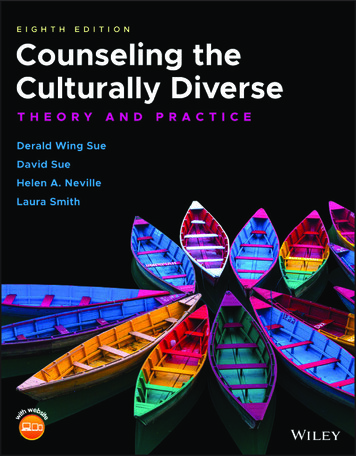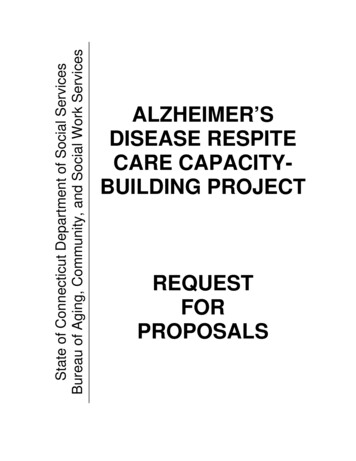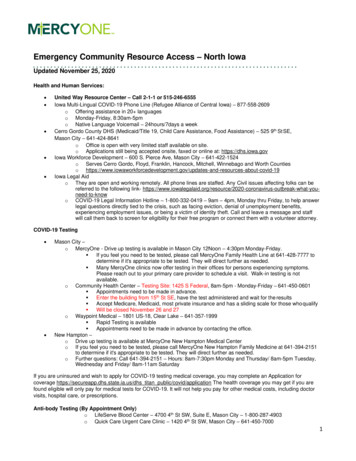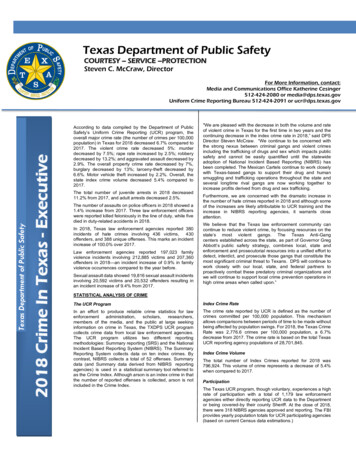
Transcription
0004230000.INDD 4241/7/2019 6:26:38 PM
Counseling theCulturally Diverse0004229963.INDD 11/16/2019 8:04:36 PM
0004229963.INDD 21/16/2019 8:04:36 PM
EIGHTH EDITIONCounseling theCulturally DiverseTheory and PracticeDerald Wing Sue David Sue Helen A. Neville Laura Smith0004229963.INDD 31/16/2019 8:04:36 PM
This edition first published 2019. 2019 John Wiley & Sons, Inc.Edition HistoryJohn Wiley and Sons, Inc. (7e, 2015)All rights reserved. No part of this publication may be reproduced, stored in a retrieval system, or transmitted, in any form or by anymeans, electronic, mechanical, photocopying, recording or otherwise, except as permitted by law. Advice on how to obtain permissionto reuse material from this title is available at http://www.wiley.com/go/permissions.The right of Derald Wing Sue, David Sue, Helen A. Neville, and Laura Smith to be identified as the authors of Counseling theCulturally Diverse: Theory and Practice, Eighth Edition has been asserted in accordance with law.Registered OfficeJohn Wiley & Sons, Inc., 111 River Street, Hoboken, NJ 07030, USAEditorial Office111 River Street, Hoboken, NJ 07030, USAFor details of our global editorial offices, customer services, and more information about Wiley products visit us at www.wiley.com.Wiley also publishes its books in a variety of electronic formats and by print‐on‐demand. Some content that appears in standard printversions of this book may not be available in other formats.Limit of Liability/Disclaimer of WarrantyWhile the publisher and authors have used their best efforts in preparing this work, they make no representations or warrantieswith respect to the accuracy or completeness of the contents of this work and specifically disclaim all warranties, including withoutlimitation any implied warranties of merchantability or fitness for a particular purpose. No warranty may be created or extended bysales representatives, written sales materials or promotional statements for this work. The fact that an organization, website, or productis referred to in this work as a citation and/or potential source of further information does not mean that the publisher and authorsendorse the information or services the organization, website, or product may provide or recommendations it may make. This work issold with the understanding that the publisher is not engaged in rendering professional services. The advice and strategies containedherein may not be suitable for your situation. You should consult with a specialist where appropriate. Further, readers should be awarethat websites listed in this work may have changed or disappeared between when this work was written and when it is read. Neitherthe publisher nor authors shall be liable for any loss of profit or any other commercial damages, including but not limited to special,incidental, consequential, or other damages.Library of Congress Cataloging‐in‐Publication DataNames: Sue, Derald Wing, author.Title: Counseling the culturally diverse : theory and practice / Derald Wing Sue [and three others].Description: Eighth edition. Hoboken, NJ : John Wiley & Sons, Inc., 2019. Includes bibliographical references and index. Identifiers: LCCN 2018042673 (print) LCCN 2018044428 (ebook) ISBN 9781119448235 (Adobe PDF) ISBN 9781119448280(ePub) ISBN 9781119448242 (paperback)Subjects: LCSH: Cross-cultural counseling.Classification: LCC BF636.7.C76 (ebook) LCC BF636.7.C76 S85 2019 (print) DDC 158.3–dc23LC record available at https://lccn.loc.gov/2018042673Cover Design: WileyCover Image: Anthony Carpinelli / EyeEm / Getty ImagesSet in 12/15pt Adobe Garamond by SPi Global, Pondicherry, IndiaPrinted in the United States of America10ffirs.indd 498765432103/06/2019 11:10:14 AM
ContentsPrefaceAbout the AuthorsSECTION ONE The Multiple Dimensions of Multicultural Counselingand TherapyPART I The Affective and Conceptual Dimensions of MulticulturalCounseling and TherapyChapter 1 Obstacles to Developing Cultural Competence and Cultural Humility:Understanding Resistance to Multicultural Training Reactions to Reading Counseling the Culturally DiverseEmotional Self‐Revelations and Fears: Majority Group MembersEmotional Invalidation Versus Affirmation: Marginalized Group MembersA Word of CautionRecognizing and Understanding Resistance to Multicultural TrainingCognitive Resistance—DenialEmotional ResistanceThe Meaning of Anxiety and FearThe Meaning of Defensiveness and AngerThe Meaning of Guilt, Regret, and RemorseBehavioral ResistanceCultural Competence and EmotionsImplications for Clinical PracticeSummaryReferencesChapter 20004229964.INDD 5Multicultural Counseling and Therapy (MCT)Culture‐Universal (Etic) Versus Culture‐Specific (Emic) FormulationsCultural Concepts of DistressAcknowledging Group DifferencesBeing Aware of Collectivistic CulturesAttuning to Cultural and Clinical CluesBalancing the Culture‐Specific and Culture‐Universal OrientationsThe Nature of Multicultural Counseling CompetenceThe Harm of Cultural InsensitivityGood Counseling Is Culturally Responsive CounselingA Tripartite Framework for Understanding the MultipleDimensions of IdentityIndividual Level: “All Individuals Are, in Some Respects,Like No Other 242629293030303131323232341/8/2019 8:18:10 PM
viContentsGroup Level: “All Individuals Are, in Some Respects, Like SomeOther Individuals” 35Universal Level: “All Individuals Are, in Some Respects, Like AllOther Individuals” 35Individual and Universal Biases in Psychology and Mental Health 36The Impact of Group Identities on Counseling and Psychotherapy 37What Is Multicultural Counseling and Therapy (MCT)? 37What Is Cultural Competence? 38Social Justice and Cultural Competence 41Implications for Clinical Practice42Summary 43References 44Chapter 3 Multicultural Counseling Competence for Counselors and Therapistsof Marginalized GroupsInterracial and Interethnic BiasesImpact on Interracial Counseling RelationshipsStereotypes Held by Socially Marginalized Group MembersThe Who‐Is‐More‐Oppressed GameCounselors from Marginalized Groups Working with Majority andOther Marginalized Group ClientsThe Politics of Interethnic and Interracial Bias and DiscriminationThe Historical and Political Relationships Between Groups of ColorAfrican Americans and Asian AmericansAsian Americans and Latinx AmericansLatinx Americans and Black AmericansAmerican Indians and Black, Latinx, and Asian AmericansDifferences Between Racial/Ethnic GroupsCultural ValuesCommunication StylesIssues Regarding Stage of Ethnic IdentityCounselors of Color and Dyadic CombinationsChallenges Associated with Counselor of Color and White Client DyadsSituation 1: Challenging the Competency of Counselors of ColorSituation 2: Needing to Prove CompetenceSituation 3: Transferring Racial Animosity toward White ClientsSituation 4: Viewing the Counselor of Color as a Super Minority CounselorSituation 5: Dealing with Client Expressions of RacismChallenges Associated with Counselor of Color and Client of Color DyadsSituation 1: Overidentifying with the ClientSituation 2: Encountering Clashes in Cultural ValuesSituation 3: Experiencing Clashes in Communication and Counseling StylesSituation 4: Receiving and Expressing Racial AnimositySituation 5: Dealing with the Racial Identity Status of Counselorsand ClientsImplications for Clinical PracticeSummaryReferences0004229964.INDD 2636364656667681/8/2019 8:18:10 PM
ContentsPART II The Impact and Social Justice Implications of Counselingand PsychotherapyChapter 4 The Political and Social Justice Implications of Counselingand PsychotherapyThe Mental Health Impact of Sociopolitical OppressionSociopolitical Oppression and the Training of Counseling/Mental Health ProfessionalsDefinitions of Mental HealthNormality as a Statistical ConceptNormality as Ideal Mental HealthAbnormality as the Presence of Certain BehaviorsCurriculum and Training DeficienciesCounseling and Mental Health LiteraturePathology and Persons of ColorThe Genetically Deficient ModelThe Culturally Deficient ModelThe Culturally Diverse ModelThe Need to Treat Social Problems—Social Justice CounselingPrinciple 1: A Failure to Develop a Balanced Perspective BetweenPerson and System Focus Can Result in False Attributionof the ProblemPrinciple 2 : A Failure to Develop a Balanced Perspective Between Personand System Focus Can Result in an Ineffective and Inaccurate TreatmentPlan Potentially Harmful to the ClientPrinciple 3: When the Client Is an Organization or a Larger System and Notan Individual, a Major Paradigm Shift Is Required to Attain a TrueUnderstanding of Problem and Solution IdentificationPrinciple 4: Organizations Are Microcosms of the Wider Society FromWhich They Originate; As a Result, They Are Likely to Be Reflectionsof the Monocultural Values and Practices of the Larger CulturePrinciple 5: Organizations Are Powerful Entities That Inevitably ResistChange and Possess Many Ways to Force Compliance Among Workers;Going against the Policies, Practices, and Procedures of the Institution,for Example, Can Bring About Major Punitive ActionsPrinciple 6: When Multicultural Organizational Development IsRequired, Alternative Helping Roles That Emphasize SystemsIntervention and Advocacy Skills Must Be Part of the Repertoireof the Mental Health ProfessionalPrinciple 7: Although Remediation Will Always Be Needed,Prevention Is BetterSocial Justice CounselingAdvocacy for Organizational ChangeSocial Justice Advocacy and Cultural HumilitySocial Justice Advocacy and Counseling RolesImplications for Clinical PracticeSummaryReferences0004229964.INDD 9091929293941/8/2019 8:18:10 PM
viiiContentsChapter 5 The Impact of Systemic Oppression Within the Counseling Process: ClientWorldviews and Counselor Credibility Locating Clients’ Problems Entirely Inside the ClientsCulturally Related Responses That Reproduce StereotypesResponding When the Issues are Our Own: White FragilityEffects of Historical and Current OppressionEthnocentric MonoculturalismBelief in the Superiority of the Dominant GroupBelief in the Inferiority of OthersPower to Impose StandardsManifestation in InstitutionsThe Invisible VeilHistorical Manifestations of Ethnocentric MonoculturalismSurviving Systemic OppressionCounselor Credibility and AttractivenessCounselor CredibilityExpertnessTrustworthinessFormation of Individual and Systemic WorldviewsLocus of ControlExternality and CultureExternality and Sociopolitical FactorsLocus of ResponsibilityFormation of WorldviewsInternal Locus of Control (IC)–Internal Locus of Responsibility (IR)Counseling ImplicationsExternal Locus of Control (EC)–Internal Locus of Responsibility (IR)Counseling ImplicationsExternal Locus of Control (EC)–External Locus of Responsibility (ER)Counseling ImplicationsInternal Locus of Control (IC)–External Locus of Responsibility (ER)Counseling ImplicationsImplications for Clinical PracticeSummaryReferencesChapter 6 Microaggressions in Counseling and PsychotherapyChristina M. CapodilupoContemporary Forms of OppressionThe Evolution of the “Isms”: dationThe Dynamics and Dilemmas of MicroaggressionsDilemma 1: The Clash of Sociodemographic RealitiesDilemma 2: The Invisibility of Unintentional Expressions of Bias0004229964.INDD 71191231241251251261291301311/8/2019 8:18:10 PM
ContentsDilemma 3: The Perceived Minimal Harm of MicroaggressionsDilemma 4: The Catch‐22 of Responding to MicroaggressionsTherapeutic ImplicationsManifestations of Microaggressions in Counseling/TherapyThe Path ForwardImplications for Clinical PracticeSummaryReferencesPART III The Practice Dimensions of Multicultural Counseling and TherapyChapter 7 Multicultural Barriers and the Helping Professional: The IndividualInterplay of Cultural Perspectives My Therapist Didn’t UnderstandStandard Characteristics of Mainstream CounselingCulture‐Bound ValuesFocus on the IndividualVerbal/Emotional/Behavioral ExpressivenessInsightSelf‐Disclosure (Openness and Intimacy)Scientific EmpiricismDistinctions Between Mental and Physical FunctioningPatterns of CommunicationClass‐Bound ValuesImpact of PovertyTherapeutic Class BiasLanguage BarriersPatterns of “American” Cultural Assumptions and MulticulturalFamily Counseling/TherapyPeople–Nature DimensionTime DimensionRelational DimensionActivity DimensionNature of People DimensionOvergeneralizing and StereotypingImplications for Clinical PracticeSummaryReferencesChapter 80004229964.INDD 9Communication Style and Its Impact on Counseling and PsychotherapyCommunication StylesNonverbal ‐Context CommunicationSociopolitical Facets of Nonverbal 601611621631631641681701711711721741751761/8/2019 8:18:10 PM
xContentsNonverbals as Reflections of BiasNonverbals as Triggers to Biases and FearsCounseling and Therapy as Communication StyleDifferential Skills in MCTImplications for MCTImplications for Clinical ulticultural Evidence‐Based Practice (EBP)Evidence‐Based Practice (EBP) And MulticulturalismEmpirically Supported Treatment (EST)ImplicationsEmpirically Supported Relationships (ESRs)The Therapeutic AllianceEmotional or Interpersonal BondEmpathyPositive Regard, Respect, Warmth, and GenuinenessSelf‐DisclosureManagement of CountertransferenceGoal ConsensusEvidence‐Based Practice (EBP) And Diversity Issues in CounselingImplications for Clinical 00201201202203206207208Chapter 10 Non‐Western Indigenous Methods of Healing: Implications for MulticulturalCounseling and Therapy (MCT) Worldviews and Cultural SyndromesThe Shaman and Traditional Healer as Therapist: CommonalitiesA Case of Child Abuse?The Principles of Indigenous HealingHolistic Outlook, Interconnectedness, and HarmonyBelief in Metaphysical Levels of ExistenceAcceptance of Spirituality in Life and the CosmosExamples of Indigenous Healing ApproachesHo’oponoponoNative American Sweat Lodge CeremonyDangers and Benefits of SpiritualityImplications for Clinical 24224224226227227228PART IV Racial, Ethnic, Cultural (REC) Attitudes in Multicultural Counseling and Therapy231Chapter 9Chapter 11 Racial, Ethnic, Cultural (REC) Identity Attitudes in People of Color:Counseling Implications 233Racial Awakening2340004229964.INDD 101/8/2019 8:18:10 PM
ContentsOriental, Asian, or White?Denial BreakdownThe Internal Struggle for IdentityLocus of the ProblemREC Identity Attitude ModelsFoundational REC ModelsA General Model of REC IdentityConformity StatusDissonance StatusResistance and Immersion StatusIntrospection StatusIntegrative Awareness StatusCounseling Implications of the R/CID ModelConformity StatusDissonance StatusResistance and Immersion StatusIntrospection StatusIntegrative Awareness StatusValue of a General REC Identity FrameworkImplications for Clinical PracticeSummaryReferencesChapter 12 White Racial Identity Development: Counseling ImplicationsUnderstanding the Dynamics of WhitenessModels of White Racial Identity DevelopmentThe Hardiman White Racial Identity Development ModelThe Helms White Racial Identity Development ModelThe Process of White Racial Identity Development: A Descriptive ModelSeven‐Step ProcessDeveloping a Nonracist and Antiracist White IdentityWhite Antiracist IdentificationsPrinciples of Prejudice ReductionPrinciple 1: Learn About People of Color From Sources Within the GroupPrinciple 2: Learn From Healthy and Strong People of the CulturePrinciple 3: Learn From Experiential RealityPrinciple 4: Learn From Constant Vigilance of Your Biases and FearsPrinciple 5: Learn From Being Committed to Personal Action Against RacismImplications for Clinical PracticeSummaryReferencesSECTION TWO Multicultural Counseling and SpecificPopulations0004229964.INDD 270271271272272273273274277PART V Understanding Specific Populations279Chapter 13 Culturally Competent AssessmentTherapist Variables Affecting Diagnosis2812831/8/2019 8:18:10 PM
xiiContentsCultural Competence and Preventing Diagnostic ErrorsCultural Self‐AwarenessCultural KnowledgeCulturally Responsive or Multicultural SkillsContextual and Collaborative AssessmentCollaborative Conceptualization ModelPrinciples of Collaborative ConceptualizationInfusing Cultural Relevance into Standard Clinical AssessmentsCultural Formulation InterviewCulturally Sensitive Intake InterviewDiversity‐Focused AssessmentImplications for Clinical PracticeSummaryReferences0004229964.INDD 12284285286287287288289290291291294295295296PART VI Counseling and Therapy with Racial/Ethnic Minority Group Populations299Chapter 14 Counseling African AmericansCharacteristics and StrengthsRacial and Ethnic IdentityImplicationsFamily StructureImplicationsSpiritual and Religious ValuesImplicationsEducational CharacteristicsImplicationsAfrican American YouthCultural StrengthsSpecific ChallengesRacism and DiscriminationImplicationsImplications for Clinical 06306307308309309310311312313Chapter 15 Counseling American Indians/Native Americans and Alaska NativesCharacteristics and StrengthsTribal Social StructureImplicationsFamily StructureImplicationsCultural and Spiritual ValuesCultural StrengthsSpecific ChallengesHistorical and Sociopolitical BackgroundImplicationsEducational 19 8:18:10 PM
ContentsImplicationsAcculturation ConflictsImplicationsAlcohol and Substance AbuseImplicationsDomestic s for Clinical PracticeSummaryReferences0004229964.INDD 13xiii322323324324325325325326326327328328Chapter 16 Counseling Asian Americans and Pacific IslandersCharacteristics and StrengthsAsian Americans: A Success Story?Collectivistic OrientationImplicationsHierarchical RelationshipsImplicationsParenting StylesImplicationsEmotionalityImplicationsHolistic View on Mind and BodyImplicationsAcademic and Occupational Goal OrientationImplicationsCultural StrengthsSpecific ChallengesRacial Identity IssuesImplicationsAcculturation ConflictsImplicationsExpectations Regarding CounselingImplicationsRacism and DiscriminationImplicationsImplications for Clinical 343344345Chapter 17 Counseling Latinx PopulationsCharacteristics and StrengthsCultural Values and CharacteristicsImplicationsFamily Structure3483503503503511/8/2019 8:18:10 PM
xivContentsImplicationsGender Role ExpectationsImplicationsSpiritual and Religious ValuesImplicationsEducational CharacteristicsImplicationsCultural StrengthsSpecific ChallengesStigma Associated with Mental IllnessImplicationsAcculturation ConflictsImplicationsLinguistic IssuesImplicationsImplications for Clinical PracticeSummaryReferences0004229964.INDD 360361Chapter 18 Counseling Multiracial PopulationsCharacteristics and StrengthsMultiracialism in the United StatesImplicationsThe “One Drop of Blood” RuleImplicationsStrengthsSpecific ChallengesRacial/Ethnic Ambiguity: “What Are You?”ImplicationsRacial Identity InvalidationImplicationsIntermarriage, Stereotypes, and MythsImplicationsDiscrimination and RacismImplicationsA Multiracial Bill of RightsImplicationsImplications for Clinical 69370370372372373373373374374374375376PART VII Counseling and Special Circumstances Involving Racial/Ethnic Populations379Chapter 19 Counseling Arab Americans and Muslim AmericansCharacteristics and StrengthsArab AmericansMuslim Americans3813823823831/8/2019 8:18:10 PM
ContentsCultural and Religious ValuesFamily Structure and ValuesImplicationsCultural StrengthsSpecific ChallengesStereotypes, Racism, and DiscriminationImplicationsAcculturation ConflictsImplicationsImplications for Clinical PracticeSummaryReferences0004229964.INDD 15xv384384385385385385387388388389390390Chapter 20 Counseling Immigrants and RefugeesCharacteristics and StrengthsHistorical and Sociopolitical FactorsCultural and Acculturation IssuesImplicationsGender Issues and Domestic ViolenceImplicationsStrengthsSpecific ChallengesPrejudice and DiscriminationImplicationsBarriers to Seeking TreatmentLinguistic and Communication IssuesImplicationsCounseling RefugeesEffects of Past Persecution, Torture, or TraumaImplicationsSafety Issues and Coping with LossImplicationsImplications for Clinical 00400400401402402403404404404405405407407Chapter 21 Counseling Jewish AmericansCharacteristics and StrengthsSpiritual and Religious ValuesEthnic IdentityGender‐Related ConsiderationsCultural StrengthsSpecific ChallengesHistorical Background and Sociopolitical ChallengesPrejudice and Discrimination4104124124134144154154154161/8/2019 8:18:10 PM
xviContentsImplications for Clinical PracticeSummaryReferences0004229964.INDD 16418420420PART VIII Counseling and Therapy with Other Multicultural Populations423Chapter 22 Counseling Individuals with DisabilitiesCharacteristics and StrengthsThe Americans with Disabilities Act (ADA)ImplicationsMyths Regarding Individuals with DisabilitiesModels of DisabilityImplicationsLife SatisfactionImplicationsSexuality and ReproductionImplicationsSpirituality and ReligiosityImplicationsStrengthsSpecific ChallengesPrejudice and DiscriminationImplicationsSupports for Individuals with DisabilitiesImplicationsCounseling Issues with Individuals with DisabilitiesImplicationsFamily CounselingImplicationsImplications for Clinical 438Chapter 23 Counseling LGBTQ PopulationsCharacteristics and StrengthsSexual and Gender Identity AwarenessImplicationsLGBTQ YouthImplicationsLGBTQ Couples and FamiliesImplicationsStrengthsSpecific ChallengesComing OutImplicationsPrejudice, Discrimination, and 4491/8/2019 8:18:10 PM
Contents0004229964.INDD 17xviiImplicationsAgingImplicationsImplications for Clinical PracticeSummaryReferences451451451452454454Chapter 24 Counseling Older AdultsCharacteristics and StrengthsPhysical and Economic HealthImplicationsSexuality in Later YearsImplicationsStrengthsSpecific ChallengesPrejudice and DiscriminationImplicationsMental DeteriorationImplicationsElder Abuse and NeglectImplicationsSubstance AbuseImplicationsSocial Isolation, Depression, and SuicideImplicationsImplications for Clinical 62463463464465466466467467468468470470Chapter 25 Counseling Individuals Living in PovertyCharacteristics and StrengthsStrengthsSpecific ChallengesThe Cultural Invisibility and Social Exclusion of the PoorEducational InequitiesImplicationsPoverty and Mental IllnessImplicationsEnvironmental InjusticeDisparities in the Judicial SystemClassism and the Minimum WageHealth Care InequitiesNegative Attitudes and BeliefsImplications for Clinical 804804804804814814824854851/8/2019 8:18:10 PM
xviiiContentsChapter 26 Counseling WomenCharacteristics and StrengthsSocietal Roles and ExpectationsImplicationsStrengthsSpecific ChallengesDiscrimination, Harassment, and VictimizationImplicationsEducational BarriersImplicationsEconomic and Employment BarriersImplicationsAgeism and WomenImplicationsDepressionImplicationsGender Bias in TherapyImplications for Clinical PracticeSummaryReferencesIndex0004229964.INDD 4984995005015051/8/2019 8:18:10 PM
PrefaceFor nearly four decades, Counseling the Culturally Diverse: Theory and Practice (CCD) has been thecutting‐edge text in multicultural counseling and mental health, used in an overwhelming majority ofgraduate training programs in counseling and clinical psychology. It now forms part of the multicultural knowledge base of licensing and certification exams at both the master’s and the doctoral levels.In essence, it has become a “classic” in the field, and continues to lead the profession in the research,theory, and practice of multicultural counseling and therapy (MCT). CCD upholds the higheststandards of scholarship and is the most frequently cited text in multicultural psychology and ethnicminority mental health.With the addition of two new co‐authors, Dr. Helen Neville and Dr. Laura Smith, to the eighthedition, instructors will note a fresh, new, and exciting perspective to the content of CCD, and theirscholarly input guarantees it will continue to rank as the most up‐to‐date text in the field. Both havebeen foremost leaders in multicultural psychology, and their voices become obvious in this revisededition.CHANGES TO CCDMuch new research has been conducted in multicultural counseling, cultural competence, social justiceadvocacy, new roles of the helping professional, White allyship, and culture‐specific interventions overthe past few years. In essence, the topical areas covered in each chapter continue to be anchors formulticultural counseling coverage. As a result, while the chapters remain similar, each has undergonemajor revisions; some are quite extensive in the updating of references, introduction of new research andconcepts, and discussion of future directions in counseling, therapy, and mental health.We maintain our two‐part division of the book, with 12 separate chapters in Section One: TheMultiple Dimensions of Multicultural Counseling and Therapy, and 13 population‐specific chaptersin Section Two: Multicultural Counseling and Specific Populations. We introduce Section Two byproviding a chapter, “Culturally Competent Assessment” (Chapter 13), that outlines the many variablesthat influence assessment, diagnosis, and case conceptualization—which, hopefully, guide the reader’sunderstanding of each specific population presented. All have been thoroughly updated using commontopical headings (when possible) that allow better cross‐comparisons between and among the groups.EFFICIENT UP‐TO‐DATE COVERAGEWe have heard from textbook adopters that the breadth and depth of coverage has made it very difficultfor instructors and students to digest the amount of material in a single course. Although reviewerssuggested that CCD be shortened, they did not recommend eliminating topics, but rather condensing,summarizing, streamlining, or eliminating certain subtopics. We have tried our best to do so withoutviolating the integrity of the content. Each of the major chapters (1 through 12) has been shortened by0004229965.INDD 191/4/2019 7:45:05 PM
xxPrefacean average of 10%, but the special population chapters have maintained their original length. This latterdecision was based on our belief that further shortening would result in the chapters having a “checklist”quality. Further, we are also aware that most instructors do not assign all special population chapters,but rather pick and choose the ones most relevant to their classes.Despite shortening major sections of the text, new advances and important changes in multicultural counseling suggest additional areas that need to be addressed. These include building onthe previous groundbreaking edition, which has become the most widely used, frequently cited, andcritically acclaimed multicultural text in the mental health field, and updating concepts to be consistent with Diagnostic and Statistical Manual of Mental Disorders (DSM‐5) categories and principles,the multicultural guidelines of the American Psychological Association, the American CounselingAssociation’s (ACA) multicultural and social justice competencies, and Council for Accreditation ofCounseling & Related Educational Programs (CACREP) standards.We also include the most recent research and theoretical formulations that introduce and analyzeemerging important multicultural topics. These include the concept of “cultural humility” as a domainof cultural competence; the important roles of White allies in the struggle for equal rights; the emergingcall for social justice counseling; the important concept of “minority stress” and its implications in workwith marginalized populations; greater focus on developmental psychology that speaks to raising andeducating children about race, gender, and sexual orientation; reviewing and introducing the most recentresearch on lesbian, gay, bisexual, transgender, and queer (LGBTQ) issues; major research developmentsin the manifestation, dynamics, and impact of microaggressions; and many others.PEDAGOGICAL STRENGTHSOne of the main goals of the eighth edition has been to better engage students in the material and allowthem to actually become active participants in digesting multicultural counseling concepts. We haveincreased our focus on pedagogy by providing instructors with exercises and activities to facilitate experiential learning for students. We open every chapter with broad chapter objectives, followed by morespecific—and oftentimes controversial—reflection and discussion questions interspersed throughout,which allow for more concentrated and detailed discussion by students on identifiable topical areas.Further, every chapter opens with a clinical vignette, longer narrative, or situational example thatpreviews the major concepts and issues discussed within. Many of these are new and serve to anchorthe multicultural issues to follow. They add life and meaning to the chapter concepts and research. Thechapter focus questions ser
The right of Derald Wing Sue, David Sue, Helen A. Neville, and Laura Smith to be identified as the authors of Counseling the Culturally Diverse: Theory and Practice, Eighth Edition has been asserted in accordance with law. Registered Office John Wiley & Sons, Inc.,










